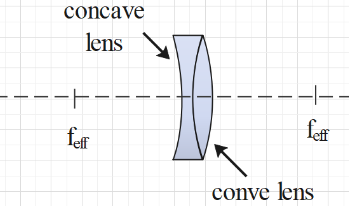
Concave and convex lenses, each has the same focal length \[20\text{ cm}\] and they are put in contact to form a combination lens. This combination lens is used to view an object of \[5\text{ cm}\] length, kept at a distance \[20\text{ cm}\] from the lens combination. As compared to the object, the image will be
(A) Magnified and inverted.
(B) Reduced and erect.
(C) Of the same size as the object and erect.
(D) Of the same size as the object but inverted.
Answer
570.3k+ views
Hint: When a concave lens and a convex lens of the same focal length are in contact, then the power of the lens combination will be zero and its focal length will be infinite. Therefore, the combination behaves as a plane glass plate.
Formula used:
The effective focal length f of a combination of two lenses having focal length \[{{f}_{1}}\] and \[{{f}_{2}}\] respectively is given by :
\[\dfrac{1}{f}=\dfrac{1}{{{f}_{1}}}+\dfrac{1}{{{f}_{2}}}\]
The lens maker’s formula for thin lens is
\[\dfrac{1}{f}=\dfrac{1}{v}-\dfrac{1}{u}\]
Where f is the focal length of the lens, u is the object distance from the lens and v is the image distance from the lens.
The magnification produced by a lens or combination of the lens is given by
\[m=\dfrac{v}{u}\]
Where u is the object distance from the lens and v is the image distance from the lens.
Complete step by step answer:

Focal length of the concave lens, \[{{f}_{\text{concave}}}=-20\text{ cm}\]
Focal length of the convex lens, \[{{f}_{\text{convex}}}=20\text{ cm}\]
Therefore, the effective focal length of the concavo-convex lens combination is:
\[
\Rightarrow
\dfrac{1}{{{f}_{eff}}}=\dfrac{1}{{{f}_{\text{concave}}}}+\dfrac{1}{{{f}_{convex}}} \\
\Rightarrow
\dfrac{1}{{{f}_{eff}}}=\dfrac{1}{-20\text{ cm}}+\dfrac{1}{20\text{ cm}}=0 \\
\]
So, the effective focal length is infinite.
The object is kept at a distance of \[20\text{ cm}\] from the lens combination. So, \[u=20\text{ cm}\]
Now, putting \[\dfrac{1}{{{f}_{eff}}}=0\] and \[u=20\text{ cm}\]in the lens maker’s formula:
\[
\Rightarrow
\dfrac{1}{{{f}_{eff}}}=\dfrac{1}{v}-\dfrac{1}{20\text{ cm}}=0 \\
\Rightarrow
\dfrac{1}{v}=\dfrac{1}{20\text{ cm}} \\
\Rightarrow
v=20\text{ cm} \\
\]
So, the image distance is equal to the object distance, that is, \[v=20\text{ cm}\].
Therefore, magnification produced by the lens is given by,
\[m=\dfrac{v}{u}=\dfrac{20\text{ cm}}{20\text{ cm}}=1\]
Therefore, the image is of the same size as the object and is erect.
Hence,option(C) is the correct answer.
Note:Remember that the focal length of the concave lens is negative as it is a diverging lens while the focal length of the convex lens is positive as it is a converging lens.Also remember that positive and negative value of magnification(m) indicates the erect and inverted image.
Formula used:
The effective focal length f of a combination of two lenses having focal length \[{{f}_{1}}\] and \[{{f}_{2}}\] respectively is given by :
\[\dfrac{1}{f}=\dfrac{1}{{{f}_{1}}}+\dfrac{1}{{{f}_{2}}}\]
The lens maker’s formula for thin lens is
\[\dfrac{1}{f}=\dfrac{1}{v}-\dfrac{1}{u}\]
Where f is the focal length of the lens, u is the object distance from the lens and v is the image distance from the lens.
The magnification produced by a lens or combination of the lens is given by
\[m=\dfrac{v}{u}\]
Where u is the object distance from the lens and v is the image distance from the lens.
Complete step by step answer:

Focal length of the concave lens, \[{{f}_{\text{concave}}}=-20\text{ cm}\]
Focal length of the convex lens, \[{{f}_{\text{convex}}}=20\text{ cm}\]
Therefore, the effective focal length of the concavo-convex lens combination is:
\[
\Rightarrow
\dfrac{1}{{{f}_{eff}}}=\dfrac{1}{{{f}_{\text{concave}}}}+\dfrac{1}{{{f}_{convex}}} \\
\Rightarrow
\dfrac{1}{{{f}_{eff}}}=\dfrac{1}{-20\text{ cm}}+\dfrac{1}{20\text{ cm}}=0 \\
\]
So, the effective focal length is infinite.
The object is kept at a distance of \[20\text{ cm}\] from the lens combination. So, \[u=20\text{ cm}\]
Now, putting \[\dfrac{1}{{{f}_{eff}}}=0\] and \[u=20\text{ cm}\]in the lens maker’s formula:
\[
\Rightarrow
\dfrac{1}{{{f}_{eff}}}=\dfrac{1}{v}-\dfrac{1}{20\text{ cm}}=0 \\
\Rightarrow
\dfrac{1}{v}=\dfrac{1}{20\text{ cm}} \\
\Rightarrow
v=20\text{ cm} \\
\]
So, the image distance is equal to the object distance, that is, \[v=20\text{ cm}\].
Therefore, magnification produced by the lens is given by,
\[m=\dfrac{v}{u}=\dfrac{20\text{ cm}}{20\text{ cm}}=1\]
Therefore, the image is of the same size as the object and is erect.
Hence,option(C) is the correct answer.
Note:Remember that the focal length of the concave lens is negative as it is a diverging lens while the focal length of the convex lens is positive as it is a converging lens.Also remember that positive and negative value of magnification(m) indicates the erect and inverted image.
Recently Updated Pages
Two men on either side of the cliff 90m height observe class 10 maths CBSE

What happens to glucose which enters nephron along class 10 biology CBSE

Cutting of the Chinese melon means A The business and class 10 social science CBSE

Write a dialogue with at least ten utterances between class 10 english CBSE

Show an aquatic food chain using the following organisms class 10 biology CBSE

A circle is inscribed in an equilateral triangle and class 10 maths CBSE

Trending doubts
Why is there a time difference of about 5 hours between class 10 social science CBSE

Write a letter to the principal requesting him to grant class 10 english CBSE

What is the median of the first 10 natural numbers class 10 maths CBSE

The Equation xxx + 2 is Satisfied when x is Equal to Class 10 Maths

Which of the following does not have a fundamental class 10 physics CBSE

State and prove converse of BPT Basic Proportionality class 10 maths CBSE




